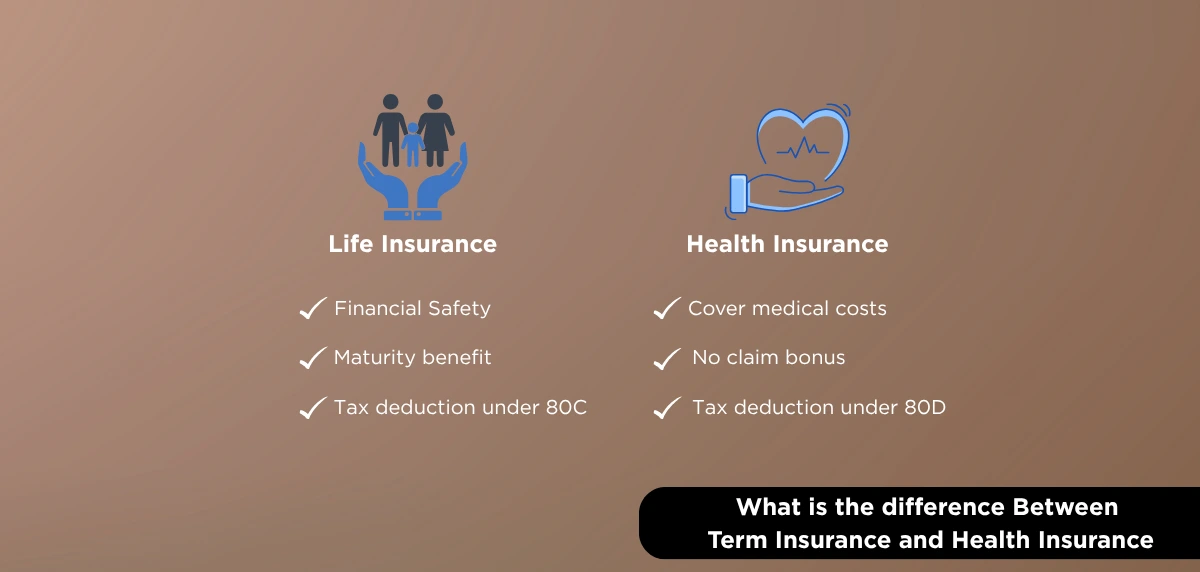In today’s times, planning for financial security is not just limited to having enough savings in your bank account. It’s also about protecting against risks you can’t always predict. That is where both term insurance and health insurance come in.
While both offer protection during life’s uncertainties, each serves very different purposes. Therefore, understanding the difference between term insurance and health insurance is crucial. Let’s look at the meaning and features of term insurance vs. those of health insurance.
What is Term Insurance?
It is type of a life insurance, where if something happens to you during the coverage period, a plan/policy/product created by an insurer, provides a financial benefit to your family or chosen beneficiary. Moreover, term insurance plans are designed to provide financial support to your family in case of the policyholder's untimely demise. The amount can help cover debts, everyday expenses, and important future goals like your child’s education or marriage. Additionally, you can also opt to buy term life insurance plans supplemented with riders. They can provide extra benefits with term insurance, for any critical illness, permanent disability, or other unfortunate events.
What is Health Insurance?
It is a type of insurance that helps cover medical and hospital expenses. It pays for costs when you’re sick, need surgery, or need to stay in the hospital due to any medical issues. It not only pays for expenses during your hospital stay but can also cover costs before admission and after discharge, along with follow-up check-ups and medicines.
The primary purpose of health insurance is to protect you and your family from the high costs of medical emergencies, reducing financial worries during difficult times. Many health insurance plans also provide the convenience of cashless treatment. This allows you to receive care at network hospitals without paying up front. It further makes the process smoother and less stressful.
What's the difference between health insurance and life insurance?##
Health insurance and life insurance protect you and your family in different ways. Knowing the difference between health insurance and term insurance can help you choose the right coverage for your needs. Here are key features of each of the following to help you understand what each type of insurance offers.
Feature
| Term Insurance
| Health Insurance
|
Benefit
| The insured’s family gets a lump sum if the insured passes away within the policy term.
| Payout/funding for medical expenses (such as hospital bills, surgery costs, treatment). Helps cover out‑of‑pocket medical costs.
|
Add‑on
| Can add riders for critical/terminal illness, permanent disability, or other eligible situations
| Can add or enhance coverage for maternity, newborn cover, OPD, and other eligible costs
|
Maturity or Return benefit
| Typically, no maturity benefit; you may get a return of premium in certain policies, where refunds of the premiums are provided at the end of the term if you survive.
| No maturity benefit. But many health plans offer a no‑claim bonus (NCB) ‒ a reward or reduction in premium/increase in benefits if you do not make any claim during the policy period.
|
Duration / Policy Term
| Durations are often up to 40 years or until a certain age, to provide continuous protection as long as required.
| Typically, annual (1‑year) renewal policies are offered, though multi‑year options are sometimes available.
|
Key Factors to Evaluate Before Choosing Insurance
Selecting the right insurance plan involves more than just comparing prices. You need to consider the coverage amount, policy duration, exclusions, and the balance between cost and benefits. Focusing on these key factors will help you choose a plan that offers the protection you and your family need in times of uncertainty. Take a look at some of the crucial factors that are unmissable before signing any health or term life insurance plans.
1. Coverage Amount:
For term insurance, make sure the sum insured is enough to cover all your future financial responsibilities. For health insurance, you can choose a coverage amount that accounts for rising medical costs in your area.
2. Policy Duration and Renewability:
Ensure your health insurance plan can be renewed for your entire life and understand how premiums may rise with age. For term insurance, see if you can increase your coverage or adjust your premium payments as and when your financial needs change.
3. Exclusions and Waiting Periods:
It is important to understand what your insurance doesn’t cover. Health plans often exclude pre-existing conditions or certain treatments and may have waiting periods. Likewise, term insurance riders usually come with specific terms and conditions that you should be aware of before making a decision.
4. Premiums vs. Benefits:
Adding extra riders can increase your premium costs. It is important to choose coverage that offers the right mix of benefits without stretching your budget. Striking the right balance ensures you get the protection you need at a price you can manage.
Term insurance and health insurance may seem similar on the surface. But they serve very different and equally important roles in your financial planning. Life doesn’t always go as planned; illnesses can come without warning, and loss can leave a family financially vulnerable. That’s why relying on just one type of insurance isn’t enough. Health insurance helps you manage medical expenses. Term insurance ensures your loved ones are financially protected if there is an untimely demise of the policyholder. Together, they give you the confidence to face whatever comes, without putting your family’s future at risk.
# Bonus rate may vary from time to time based on Company’s Investment Performance.





















